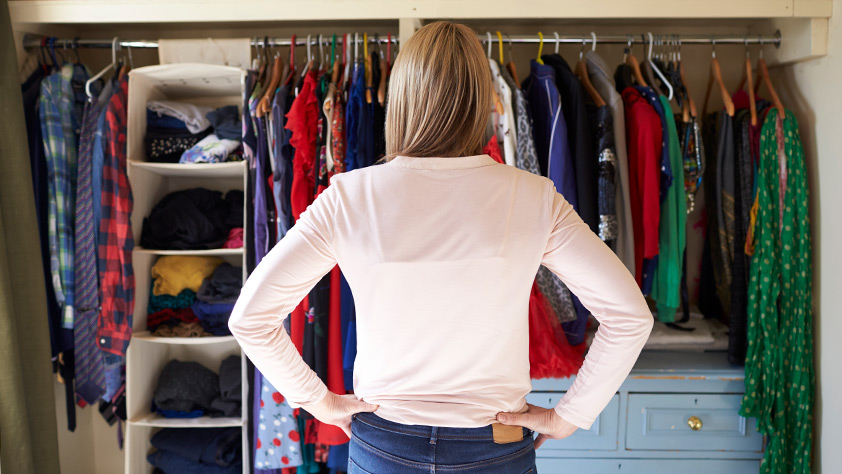Wondering how you can go back to school in style without spending too much? Clothing costs can be a concern, but these wardrobe tips from DC Style Factory founder and chief stylist Rosana Vollmerhausen can help you get more mileage out of the clothing and accessories you already have. Then you can shop strategically and spend less if you need a few new pieces.
First, decide how much you want to spend. Then, after you’ve set your wardrobe budget, survey your closet to see what you really need.
Build a foundation of staple pieces
Vollmerhausen calls these the “building blocks” of your personal style. “These are the wardrobe workhorses that make creating outfits easy and possible,” she says.
You might have a closet full of clothes you love but still not have a solid foundation, she says. As a personal stylist, Vollmerhausen sees many clients whose closets contain many “special pieces” without enough essentials to anchor them.
What kind of clothing items are staples? “The black pants, those perfect dark jeans, the easy-to-layer cream sleeveless blouse, the black blazer,” Vollmerhausen says. These basic pieces may not have many bells and whistles compared with those special pieces you love, but you need them so you’ll have a versatile, functional wardrobe.
With a solid foundation of basics to build on, you don’t really need to have a lot of additional clothing to have many options for a variety of different outfits.
Your wardrobe foundation should include:
- One week’s worth of bottoms: seven trousers, jeans, skirts or a mix of these pieces
- Two week’s worth of tops: 14 blouses and T-shirts (because tops usually need more laundering than bottoms)
- Five layering pieces such as cardigans, blazers and jackets
- Five pairs of shoes including two pairs of flats, one pair of comfortable pumps, one pair of flat ankle boots and one pair of nonathletic sneakers.
Basic pieces should be transitional or seasonless, meaning clothing you can wear throughout the year.
After you have your foundation, then you can supplement with seasonal clothes such as thicker pullover sweaters and coats.
Extend the life of your current wardrobe
Whatever your style, Vollmerhausen says your look will fall apart if your clothes appear worn or don’t fit properly. If a garment you want to keep doesn’t fit as well as it should, have it altered. “It’s worth the investment,” she states.
Extend the useful life of your clothes by taking good care of them, even if they didn’t cost much. Treat budget clothing as well as you would treat pricier garments.
That means washing clothes on the delicate cycle, hanging or laying flat to dry, and using a warm iron if pressing is needed, Vollmerhausen explains: “All these steps will help preserve the quality and integrity of your clothing.”
Bonus: Making your clothes last longer means you won’t need to replace pieces as often, which will help your budget last longer.
Revitalize wardrobe items you want to keep
Extend the useful life of wardrobe items that are still wearable but may not be in style or look new.
For example, if you have an older blazer that just feels outdated, take it to a tailor to see if the sleeve length can be adjusted, if the waist is nipped in enough or if the sleeve can be narrowed, Vollmerhausen says. Alterations like these “will automatically make for an updated style of blazer and typically cost $20 to $50.”
If trousers need a new look, consider narrowing the leg into a classic “cigarette pant” silhouette (think Audrey Hepburn) that will update your style.
Shoes gain a new life when you take them to your local cobbler, Vollmerhausen says. “You would not believe what a simple heel repair, buffing and shining will do to bring your shoes back to life.”
Give your jewelry a modernizing makeover by layering a few delicate pieces to create one larger necklace that makes a bolder statement. Combine pearls and chains, and don’t be afraid to mix gold and silver.
Every item you can successfully update is an item you won’t have to spend money to replace.
Shop for deals, but be careful with sales
Before you shop, know which items are worth spending more money on and which can cost less. Vollmerhausen encourages her clients to invest in shoes, blazers and purses and to save on blouses and trousers. “Our philosophy is quality over quantity—spend more and buy less.”
Audit your closet first and create a list of essentials before you shop. “List the items you truly need and do a line-item budget so you know how much you can spend on each piece,” Vollmerhausen says.
She recommends shopping exclusively for deals and sticking to your list. Don’t let a “too good to pass up” deal or sale sway you into an unplanned splurge. “If something you really need is on sale and fits great, then yes, buy it,” she says. But remember, shopping the sale racks exclusively can actually lead to unnecessary purchases.
There’s a difference between shopping deals and shopping sales, Vollmerhausen says. She doesn’t encourage exclusively sale shopping because sales are always happening, and it’s easy to go overboard or buy things you don’t really need.
The trick is to keep your budgeted and prioritized shopping list ready to go so when you find things that are on your list, you can try them on and “earmark the items you like and that work for you,” she says. That doesn’t necessarily mean buy them, though. If the price is higher than you’ve budgeted for, you can always wait for those particular items to go on sale.
Use your membership benefits to shop and get rewarded
The NEA Discount Marketplace is a great way to find deals and earn cash-back from retailers as you strategically search for professional attire for teachers, paraprofessionals, professors and more. Find out more about how the program works, or go ahead and start shopping now.





